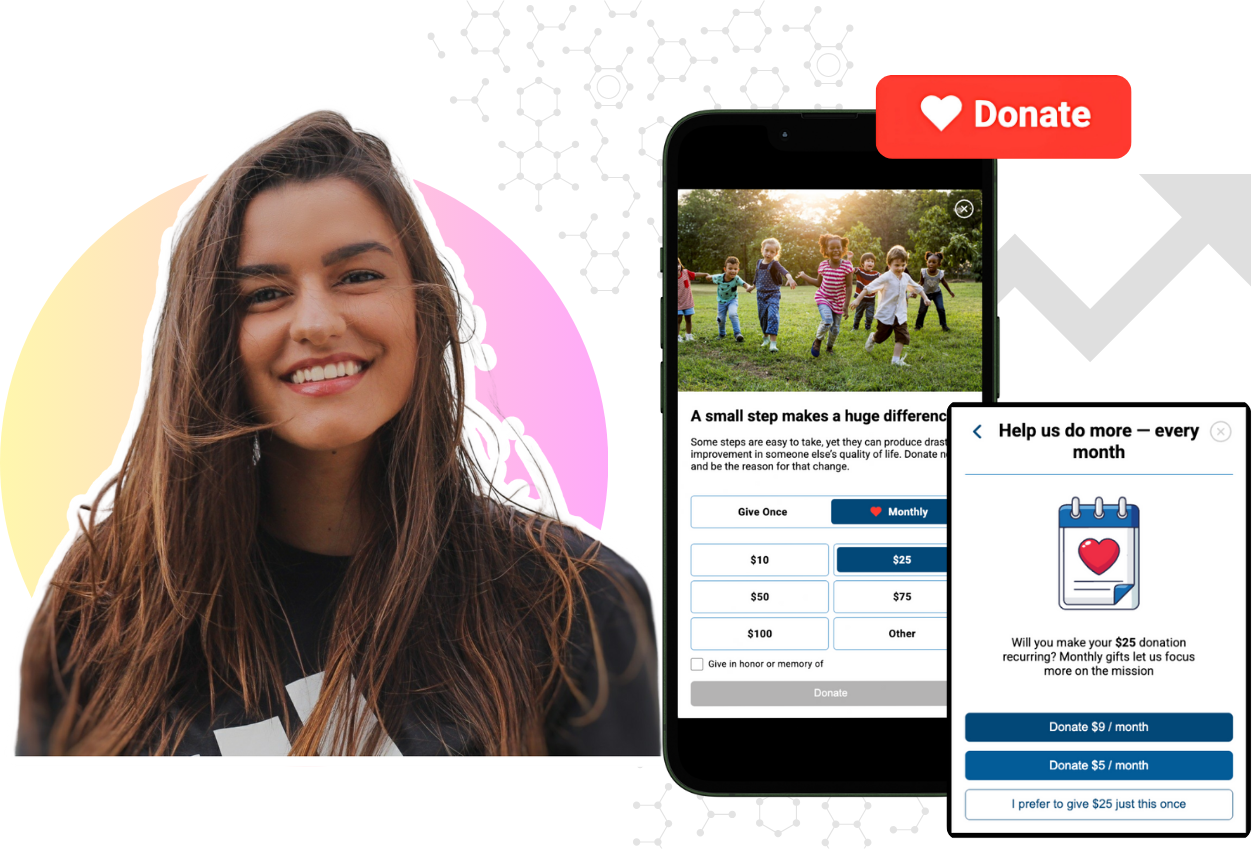Donors Want to Feel Connected
The busier and more crowded our lives become, the greater the gap between what remains important to us and all the other things seeking our...

Mobile-First Pop-Up Donation Form
Launch mobile-first pop-up forms in minutes, use built-in tools to capture more donations, and optimize the giving experience—no dev team required.
New to online donation pages for your nonprofit? Start here.
Donation page A/B testing - no science degree needed.
Keep your donation page loading fast - and drive higher conversions.

The 4 Types of Online Donation Experiences
89% of donors leave without giving. Learn how to use the right donation form to close the gap and boost conversions.

On a daily basis, we all see how businesses in the for-profit world build relationships with consumers by addressing the interests, lifestyles, and needs of their customers through personally relevant, actionable marketing messages that build loyalty and advocacy. Nonprofits recognize the virtue of creating a sustainable, transparent, trusted organization by developing ongoing, long-term donor relationships.
Successful for-profit businesses access people across all channels, all touchpoints, as part of a larger strategy that is grounded in a comprehensive grasp of the customer lifecycle. The results speak for themselves: Businesses that make the investment in their consumer experience outperform laggards in the industry by 80 percent, over and over.
The success for-profit companies have achieved in this way is, in fact, emblematic of what nonprofits can achieve. Yet, the majority of NPOs may still not be aware of the price they’re paying by not recognizing the effectiveness of these practices and putting them to work for themselves. For example, by ignoring the online channels that potential donors are frequenting, nonprofits are leaving upwards of $36 billion in potential donations on the table.
Nonprofits still need to interact with their donors consistently, and still need to communicate the impact of the work being conducted to inspire passion for their cause. And the way to do that is by bringing their strategy, systems, processes – indeed, their entire attitude and approach – into close alignment with the donor lifecycle.
Discovery
Although it may seem obvious, establishing trust with the donor starts with an NPO making itself as “discoverable,” or accessible as possible. Typically, the very first experience a potential donor has with an NPO involves search results, their website, perhaps an unsolicited email, or social media.
Meeting donors where they are must be seen as a given. Engaging with potential donors in channels they’re already familiar with positions you as a regular participant on the platform, and over time drives familiarity for the donor. This is why it’s crucial for NPOs to create multiple avenues of accessibility. The bottom line: nonprofits need to be easily found.
Keys to a successful Discovery phase:
Consideration
The Consideration phase really comes down to one thing: connecting with the donor on an emotional level. Just because a donor has reached this phase doesn’t mean a donation is guaranteed. The first order of business is to anticipate and answer top-of-mind questions that can be expected from donors.
Addressing the skeptical donor is essential if you want to tap into the donor’s interest, curiosity, and emotional engagement. Successfully answering these early questions opens the door to additional communication.
Keys to a successful Consideration phase:
Point of Giving
A donor-first giving experience should be a clear, easy, intuitive gifting process. Part of that requires providing an array of online giving methods (e.g., credit card, Paypal, Venmo, etc.). Likewise, it’s important to communicate the power of the donor’s gift and how it is contributing to positive change at the point of giving.
Keys to a successful Point of Giving phase:
Advocacy
The true test of a successful nonprofit strategy is transitioning an individual from one-time donor to someone who’s an advocate for your cause. The way to do that is through engagement. And the key to ongoing engagement is clearly demonstrating for the donor the material impact their donation has made.
Nonprofits need to provide donors with multiple channels for frequent communication and opportunities to feel involved. This facilitates donors to promote the cause within their own networks.
Keys to a successful Advocacy phase:
By leveraging the donor lifecycles, using many of the same best practices demonstrated by for-profit companies in consumer-driven businesses, nonprofits can build donor relationships through giving experiences that establish trust and transparency. At the same time, they are opening the door to capture new donor segments in new channels that may not have been previously considered.
iDonate’s Digital Fundraising Platform (DFP) provides nonprofits with the capabilities to identify and strengthen ties with new potential donors, accelerate conversions, and achieve sustainability by tapping into the donor lifecycle. Visit iDonate to learn more.

The busier and more crowded our lives become, the greater the gap between what remains important to us and all the other things seeking our...

While it may not be “news,” recent data on giving in America paints a troubling and persistent trend. Reports show that fewer than half of American...

Every NPO aspires to create a donor base that is recurring and sustainable. Nonprofits don’t close the loop well, which is why 75%-80% of donors...